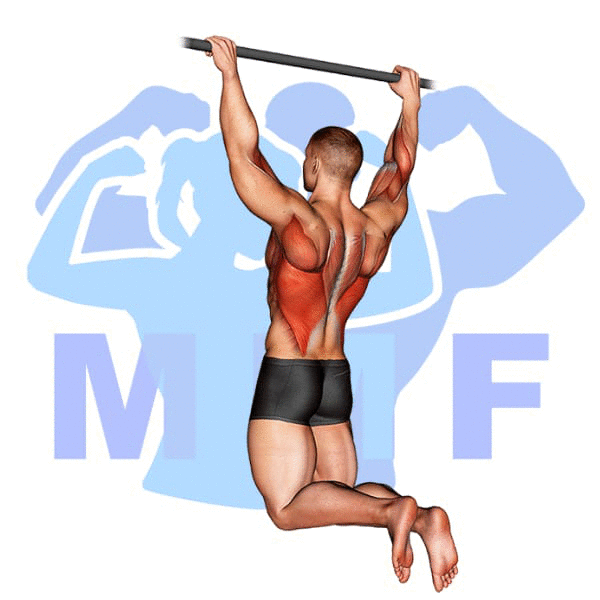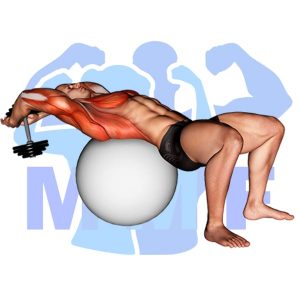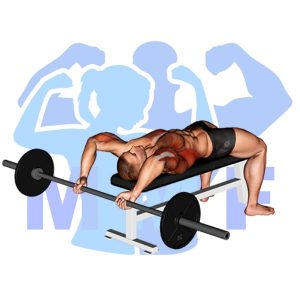Do you struggle with performing the rear pull up exercise? You’re not alone. For many fitness enthusiasts, the rear pull up can be an elusive exercise that leaves them feeling frustrated and discouraged. The cause of this struggle is often a lack of upper body strength, which can make it difficult to lift one’s own body weight. Don’t worry, though, because in this post, we’ll provide you with tips and guidance to master the rear pull up and achieve your fitness goals.
Rear Pull Up Summary
- Primary Muscles: Latissimus Dorsi
- Secondary Muscles: Brachialis, Brachioradialis, Deltoid – Posterior, Infraspinatus, Levator Scapulae, Pectoralis Major-Sternal, Pectoralis Minor, Rhomboids, Teres Major, Teres Minor, Trapezius – Lower, and Trapezius – Middle
- Equipment: Pull Up Bar
- Mechanics Type: Compound
- Force: Pull
- Utility: Basic

Rear Pull Up Instructions
- Step up and grab the bar with a wide overhand grip. Pull your body up your head under the bar until the back of your neck contacts the bar.
- Lower your body until your arms and shoulders are fully extended.
- Continue your rear pull ups for a complete set.
Video Tutorial
Rear Pull Up Muscles
Target (Agonist)
- Latissimus Dorsi
Synergists
- Brachialis
- Brachioradialis
- Deltoid – Posterior
- Infraspinatus
- Levator Scapulae
- Pectoralis Major – Sternal
- Pectoralis Minor
- Rhomboids
- Teres Major
- Teres Minor
- Trapezius – Lower
- Trapezius – Middle
Dynamic Stabilizers
- Biceps Brachii
- Triceps – Long Head
Stabilizers
- Erector Spinae
- Gluteus Medius
- Gluteus Minimus
- Levator Scapulae
- Obliques
- Quadratus Lumborum
- Tibialis Anterior
- Trapezius – Middle
- Trapezius – Upper
Antagonist Stabilizers
- None

Benefits of Rear Pull Up
The Rear Pull Up is a great exercise for targeting the Latissimus Dorsi muscle, one of the largest muscles in the back. This exercise can help to improve posture and strengthen the entire back. By performing the Rear Pull Up regularly, the Latissimus Dorsi can be strengthened and toned, while also increasing overall strength and stability. Additionally, this exercise can help to improve core strength, as it requires engaging the abdominal muscles in order to stabilize the body while performing the movement. This can help to reduce back pain and improve overall physical fitness.
Tips for Performing Rear Pull Up
If you’re seeking to take your rear pull up to a new level, then you’re at the right place. These tips will get you more from of this amazing workout, and help you reap all the benefits it has to offer. You’ll have the ability to develop your lats muscles, and minimize your chance of getting hurt. Let’s get begin and see what these tips can accomplish for you.
- Engage your core: Keep your core tight and engaged throughout the exercise to ensure you get the most out of your pull up. This will help you get the best results and prevent injury.
- Slow and steady: Move through the exercise slowly and with control to maximize the benefit of each repetition. This will help you build strength, stability and better form.
- Use momentum: Take advantage of momentum to help you pull yourself up and take some of the strain off your arms. This will make the exercise easier and more efficient.
Benefits and Tips Video
Frequent Mistakes To Avoid
Staying away from errors can be the difference between a productive training session and an injury when performing rear pull up. From improper form to not engaging your core, these errors can reduce the effectiveness of the exercise and can even raise your risk for injury. But relax, it’s not as challenging as it might seem. By knowing the errors to avert and taking the appropriate actions, you can execute the exercise securely and effectively. So it is time for you to maximize your results from this exercise and experience the benefits of a successful workout.
- Not using a full range of motion – Many people make the mistake of not fully extending their arms when doing rear pull ups. This prevents the muscles from fully engaging and limits the effectiveness of the exercise.
- Not controlling the movement – People often make the mistake of not controlling the movement when they perform rear pull ups. This can lead to strain on the joints and can increase the risk of injury.
- Not using proper form – People often do not use proper form when doing rear pull ups. This can lead to poor execution of the exercise, making it less effective and potentially more dangerous.
Find More Bodyweight Exercises Here
Variations and Complementary Exercises
If you’re looking to mix up your Rear Pull Up routine, there are plenty of variations, complementary, and alternative exercises to choose from. Below, we’ll list some of the best options for targeting the same muscles as a Rear Pull Up.
Reverse Grip Lat Pulldown

The Reverse Grip Lat Pulldown is a great complementary or alternative exercise to the Rear Pull Up. It works the same muscles in the back, but with a different grip. This exercise involves sitting on a lat pulldown machine and gripping the bar with an overhand grip. To perform this exercise, pull the bar down to your chest, pause for a second, and then slowly release. This exercise is great for targeting your lats and upper back muscles, as well as strengthening your grip.
Stability Ball Dumbbell Pullover

Stability Ball Dumbbell Pullover is an excellent complementary exercise to the Rear Pull Up. It helps to target the same muscles used in the Rear Pull Up, including the rhomboids and latissimus dorsi, while providing a more stable surface to perform the exercise. This exercise also helps to strengthen the core as well as the back muscles while also stretching the chest. In addition, it can be used as an alternative exercise for those who cannot perform a full Rear Pull Up due to lack of strength or range of motion.
V Bar Lateral Pulldown

The V Bar Lateral Pulldown is a great alternative or complementary exercise to the Rear Pull Up. This exercise targets the same muscles as the Rear Pull Up, such as the trapezius, latissimus dorsi and biceps, but with a slightly different motion. To perform the V Bar Lateral Pulldown, sit at a pulldown machine with a wide-grip bar attachment. Grasp the bar with both hands and pull it down towards your chest while keeping your elbows close to your sides. This exercise helps to strengthen and tone the back muscles, and is a great way to add variety to your back workout routine.
Check Out These Top Bodyweight Exercises
Wide Grip Pull Up

Wide Grip Pull Up is a great exercise for targeting the lats and building upper body strength. It is an excellent alternative or complementary exercise for the Rear Pull Up. The Wide Grip Pull Up puts more emphasis on the lats and upper back, while still working the biceps and shoulders. Additionally, it requires a greater range of motion compared to Rear Pull Up, which can help build greater overall strength and stability in the back muscles. Wide Grip Pull Ups can also be done with a weighted belt to add additional resistance and challenge.
Barbell Bent Arm Pullover

Barbell Bent Arm Pullover is an excellent exercise for strengthening the upper back muscles, which can be complementary or an alternative to Rear Pull Up. It is a great way to target the same muscles used in a Rear Pull Up without having to use any additional equipment. The exercise requires you to lie on your back with your legs bent and feet flat on the floor, holding a barbell with both hands above your chest. You then lower the barbell behind your head until your arms are straight. The motion of the exercise works the lats, rhomboids, and teres major muscles. It is important to keep your elbows slightly bent when performing the exercise and to ensure that you are using proper form for maximum benefit.
Close Grip Lat Pulldown

Close Grip Lat Pulldown is an exercise that targets the same muscle groups as Rear Pull Up, with the main difference being that the resistance is provided by a cable machine instead of bodyweight. It is an excellent alternative or complementary exercise to Rear Pull Up, as it provides a more controlled and adjustable range of motion. The close grip on the bar also helps to recruit more of the back muscles and increase the difficulty of the exercise. This is a great way to build strength in the back and develop a strong, muscular physique.
Find More Back Exercises Here
Opposing Complementary Exercises
For additional exercises that complement the Rear Pull Up, try incorporating exercises that use opposing muscle groups. This will ensure that the muscles used during the Rear Pull Up are balanced and that the body is working in harmony. Below is a list of exercises to help strengthen the opposing muscle groups.
Seated Dumbbell Military Press

The Seated Dumbbell Military Press is an excellent exercise to pair with the Rear Pull Up. This exercise targets the shoulder muscles, which are the opposing muscle group to those used in the Rear Pull Up. The Seated Dumbbell Military Press requires you to press the weights upwards while sitting in an upright position. This works to engage and strengthen the deltoids, as well as the triceps. With this exercise, you can focus on proper form and posture to ensure that you are getting the most out of your workout. Not only will this exercise help to further develop your shoulder muscles, but it will also help you to improve your posture and overall strength. This exercise pairs perfectly with the Rear Pull Up, as it works in opposition to build a strong and balanced physique.
Seated Dumbbell Parallel Grip Shoulder Press

The Seated Dumbbell Parallel Grip Shoulder Press is a great complement to the Rear Pull Up exercise. This exercise targets the anterior (front) deltoids, as well as the triceps and traps. The Rear Pull Up targets the posterior (back) deltoids, upper back and biceps, so it is important to balance out your workout with exercises that target the opposing muscle groups. The Seated Dumbbell Parallel Grip Shoulder Press will help to strengthen the front of your shoulders, making your back muscles stronger and more balanced. It will also help to improve your posture, making you look more confident and attractive.
Shoulder Press With Bands

The Shoulder Press with Bands is a great exercise to complement the Rear Pull Up. This exercise works the opposite muscle group as the Rear Pull Up, focusing on the deltoids and upper back muscles. The band provides resistance during the movement, making it an excellent addition to any workout routine. It helps to improve posture and strengthen the muscles around the shoulder joint. This exercise can be performed with just bodyweight or with additional weight depending on your fitness level. The Shoulder Press with Bands is a great way to add variation and challenge to your workout while still focusing on the same muscle groups as the Rear Pull Up.
Level Up Your Fitness with Rear Pull Ups
Once you’ve mastered pull-ups, try incorporating rear pull-ups into your routine to take your fitness to the next level. Rear pull-ups are a great way to target your back muscles and improve your overall upper body strength. By adding this exercise to your routine, you’ll not only see improvements in your physical appearance, but also in your overall health and well-being. Don’t be intimidated, start with a modified version and gradually work your way up to the full exercise. With consistency and determination, you’ll be able to execute this exercise with ease and reap the benefits of your hard work.
References: Wikipedia | ExRx.net | PubMed.gov | Comprehensive List of Back Bodyweight Exercises



